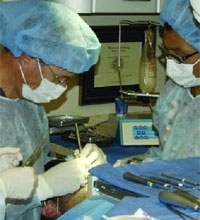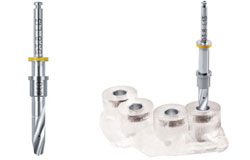Implant Surgery

In its most basic form the placement of an osseointegrated implant requires a preparation into the bone using either hand osteotomes or precision drills with highly regulated speed to prevent damaging the bone. After a variable amount of time to allow the bone to grow onto the surface of the implant (osseointegration) a tooth or teeth can be placed on the implant. The amount of time required to place an implant will vary depending on the experience of the practitioner, the quality and quantity of the bone and the difficulty of the individual situation.

At edentulous (without teeth) jaw sites, a pilot hole is bored into the recipient bone, taking care to avoid the vital structures (in particular the inferior alveolar nerve and the mental foramen within the mandible). Drilling into jawbone usually occurs in several separate steps. The pilot hole is expanded by using progressively wider drills (typically between two and seven successive drilling steps, depending on implant width and length). Care is taken not to damage the osteoblast or bone cells by overheating. The implant screw can be self-tapping, and is screwed into place at a precise torque so as not to overload the surrounding bone.
The amount of time required for an implant to become osseointegrated is a hotly debated topic. Consequently the amount of time that practitioners allow the implant to heal before placing a restoration on it varies widely. In general, practitioners allow 2-6 months for healing but preliminary studies show that early loading of implant may not increase early or long term complications. If the implant is loaded too soon, it is possible that the implant may move which results in failure.








